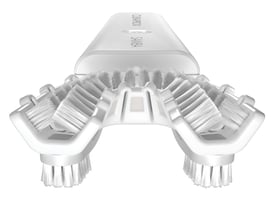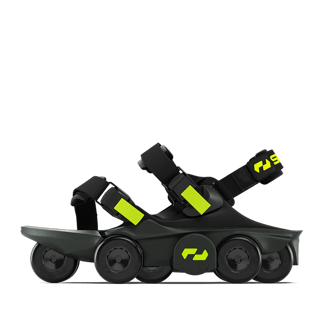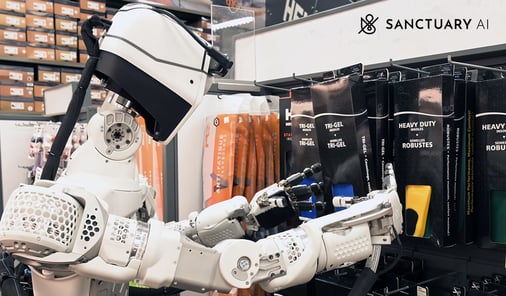What’s New in Robotics? 10.11.2023

Posted on Nov 10, 2023 7:30 AM. 10 min read time
News briefs for the week take a look at robotics from Time Magazine’s annual Best Inventions of the Year 2023 to see how robotics has pervaded many other categories of new inventions. From sleeping infants to brushing teeth to motorized shoes to humanoid robots working in the “real” world and then to a prosthetic ankle that mimics Mother Nature’s. And finally, an unlikely, teeny robot made of oak wood that could replant millions of hectares of deforested land.
Time’s Best! for 2023
 It’s that time of year again.
It’s that time of year again.  Annually, when Time Magazine announces its choices for Best Inventions of the Year 2023, it’s amazing how much of robotics has infiltrated the 200 choices from Time’s 22 categories.
Annually, when Time Magazine announces its choices for Best Inventions of the Year 2023, it’s amazing how much of robotics has infiltrated the 200 choices from Time’s 22 categories.
And yes, Robotics has its very own category in Time’s Best list, yet nearly a dozen other categories have seen robotics slip into their ranks with an invention or two. And these days with artificial intelligence (AI) converging with robotics, seems no category is immune from robotics among its winners.
Robotics into everything is now the way of the world, and it’s getting more pervasive with each day. Here are five to think about:
Hush now baby don’t you cry
 SNOO, as in snooze, is an automated bassinet invented by Dr. Harvey Karp, a renowned pediatrician and sleep expert. See his company: Happiest Baby. The website states that “Most SNOO babies sleep 9 hours or more by 2-3 months!” all for a wallet-busting $1700.
SNOO, as in snooze, is an automated bassinet invented by Dr. Harvey Karp, a renowned pediatrician and sleep expert. See his company: Happiest Baby. The website states that “Most SNOO babies sleep 9 hours or more by 2-3 months!” all for a wallet-busting $1700.  But if you are sleep-deprived new parents, then maybe the price is right. Happiest Baby’s annual revenue: $100 million.
But if you are sleep-deprived new parents, then maybe the price is right. Happiest Baby’s annual revenue: $100 million.
SNOO is an automated rocker that imitates the gentle motion in utero, with an added white-noise machine for quiet slumber.
Karp and his wife Montée Karp launched the SNOO in 2016 and have since been “hailed as visionaries — the saviors of sleep.” Vogue called SNOO a "mechanical Mary Poppins.”
Based on a Karp sketch, MIT Media Lab's Deb Roy was enlisted to build a prototype, and Fuseproject's Yves Béhar to design it. The rest is history.
Robot toothbrush with 12,900 soft bristles
 Dr. Steffen Mueller,
Dr. Steffen Mueller,  managing director of Swiss oral-health company Curaprox, says that on average, 88% of people with disabilities have tooth decay and that existing vibrating toothbrushes are hard to effectively use for the mobility impaired, especially to clean in hard-to-reach spaces.
managing director of Swiss oral-health company Curaprox, says that on average, 88% of people with disabilities have tooth decay and that existing vibrating toothbrushes are hard to effectively use for the mobility impaired, especially to clean in hard-to-reach spaces.
Enter Samba Robotic Toothbrush. Constructed like the U-shape of the mouth, the user inserts the Samba, closes his/her mouth around it and simply pushes the start button. Pre-loaded with toothpaste, the Samba’s 12,900 moving bristles do the rest (see video).
The Samba automatically “moves around the gumline and oscillates at both high and low frequencies to cover every tooth and groove, with no motion required of the user.”
“The world’s fastest shoes!”
 The website for Pittsburgh-based Shift Robotics says it all: “The world’s fastest shoes! Take the first steps into the future. With an intuitive AI drivetrain, you can walk at the speed of a run. It's like having a moving walkway...on your feet.”
The website for Pittsburgh-based Shift Robotics says it all: “The world’s fastest shoes! Take the first steps into the future. With an intuitive AI drivetrain, you can walk at the speed of a run. It's like having a moving walkway...on your feet.”
The company’s battery-powered, wheeled Moonwalkers—for $1300 a pair—boost walking speeds up to 250%. These shoes allow you to walk normally (not skate), just faster and more easily. Great for the letter carrier in your family (see video).
 Moonwalkers use AI to sense when you’re speeding up or slowing down and adjust themselves accordingly, and the wheels lock when you’re taking the stairs.
Moonwalkers use AI to sense when you’re speeding up or slowing down and adjust themselves accordingly, and the wheels lock when you’re taking the stairs.
When asked about using Moonwalkers on crowded sidewalks, company founder and CMU grad Xunjie Zhang said: “Our AI has instantaneous response times, so they are super agile, and you can seamlessly move about in a crowd.”
Zhang says walking needs an upgrade. “Our basic form of movement hasn’t changed in 6 million years, we still want the same way our great-great-great-great grandparents walked: slowly,” Zhang said. “The way we walk is stuck in the past. It’s time to bring it up to speed.”
“Despite the name, the Moonwalkers are fairly heavy, at four pounds,” reports TechCrunch. “That takes some getting used to. Likely your muscles will be a bit sore after day one. The weight is due to the drive trains and battery.”
Zhang says that on a charge Moonwalkers should get about a six-mile range, except on hills or other variables.
Maybe an Olympic event in this someday (LA Olympics 2028); or has Red Bull seen these yet?
Humanoid robot gets first “real” job
 Phoenix got a job! Standing 5 feet 7 inches, Phoenix, the humanoid robot from Vancouver-based Sanctuary AI, got a job in Mark’s retail store, and then another at a Sport Chek store. Both employment firsts for its kind.
Phoenix got a job! Standing 5 feet 7 inches, Phoenix, the humanoid robot from Vancouver-based Sanctuary AI, got a job in Mark’s retail store, and then another at a Sport Chek store. Both employment firsts for its kind.
Geordie Rose, CEO and  co-founder of Sanctuary AI (founded in 2018), says he believes that humanoid robots will be a defining technology for the 21st century.
co-founder of Sanctuary AI (founded in 2018), says he believes that humanoid robots will be a defining technology for the 21st century.
Goldman Sachs predicts that the market for humanoid robots could be worth $150 billion a year worldwide within 15 years - and that humanoid robots will be viable in factories between 2025-2028 and in other jobs by 2030-2035.
Phoenix must think its skills are ready now; it already has loaded items into a bag, cleaned mirrors, sorted objects, stocked fridges, along with tagging, labeling, and folding clothes, say its creators.
Rose praised the humanoid but added: “While we're immensely proud of our physical robot, the real star of the show is the underlying software [Carbon].”
Carbon is a revolutionary cognitive architecture and software platform for general-purpose humanoid robots. “It integrates modern AI technologies to translate natural language into action in the real world. Carbon enables Phoenix to think and act like a person to complete tasks.”
ETH Zurich is out with a report on all 27 humanoid robot models in existence. Download and compare one to the other. Both Rose and Goldman Sachs may be correct in their forecasts.
Finally, a robotic ankle that performs like a human ankle
 Making walking ultra-difficult, especially on inclines or when climbing stairs, the 'passive' joints in traditional prostheses can't fully replicate the biomechanical functions of a biological leg. So says Tommaso Lenzi, associate professor at the University of Utah's Department of Mechanical Engineering and director of the HGN Bionic Engineering Lab, makers of the new Utah Bionic.
Making walking ultra-difficult, especially on inclines or when climbing stairs, the 'passive' joints in traditional prostheses can't fully replicate the biomechanical functions of a biological leg. So says Tommaso Lenzi, associate professor at the University of Utah's Department of Mechanical Engineering and director of the HGN Bionic Engineering Lab, makers of the new Utah Bionic.
Then too, favoring the good leg over the prosthesis can cause secondary complications, such as back pain and osteoarthritis.
prosthesis can cause secondary complications, such as back pain and osteoarthritis.
Making a prosthetic ankle that closely mimics human ankle–foot biomechanics has been a near-impossible undertaking. Only recently, since 2009, has substantial progress been achieved.
Lenzi and his team finally accomplished what was formerly considered impossible.
The Utah Bionic Leg uses motors, processors and advanced artificial intelligence that work in concert to give amputees the power and mobility to do things that might seem routine to the average person, such as walk, stand up, sit down, walk up and down stairs and ramps and even traverse uneven ground.
A university PR release read: "The leg uses custom-designed force and torque sensors as well as accelerometers and gyroscopes to help determine the leg's position in space. Those sensors are connected to a computer processor that translates the sensor inputs into movements of the prosthetic joints."
Robot made from an oak tree
 Not winning a Time’s Best award was this little robot. But just maybe it should have.
Not winning a Time’s Best award was this little robot. But just maybe it should have.
Not every robot needs to be steel, aluminum, plastics, and precision. With a little ingenuity, almost anything can be autonomous, robotic or both. CMU’s Morphing Matter Lab is a believer. So much so, that the students made a remarkable robot from oak.
Steve Nouri, a global tech evangelist, wrote this about the robot made in CMU’s Morphing Matter Lab. “This robot epitomizes the fusion of human innovation and nature’s wisdom in combating deforestation and replenishing ecosystems. The robot's genius lies in emulating natural processes, using three anchor points for precision and stability. By mimicking how plants propagate seeds, it thrusts them into the soil with calibrated coils, safeguarding them from natural threats.”
Approximately 13 million hectares of forest are lost annually due to deforestation. Here’s a robot ready to replant them (see video).


Leave a comment